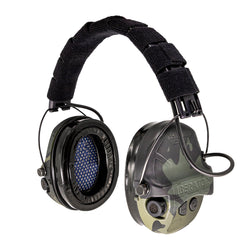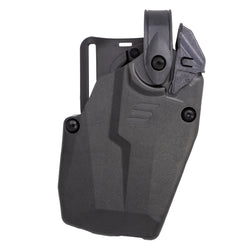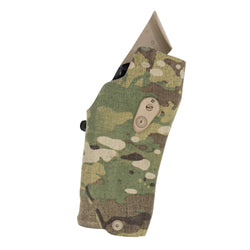I have had more than one student in a class tell me other instructors have told them that they only needed to train for “Three yards, three rounds and three seconds.” Sometimes they replace the “three” with “five.” A lot of cops will tell you to train at a max distance of seven to ten feet away because that is their average engagement range.
I was getting some personal training in at my gun club today just before I started writing this article. A guy was obviously “teaching” someone as they took over the range bay from me. The “student” said, “Glad you brought targets. I forgot mine.” His instructor replied, “Remember, we don’t shoot targets!”
I turned and looked at him, wondering what he would say next. He did not disappoint. After asking if the student had been doing his dry fire homework, he quickly followed up by saying, “You won’t see your dot or iron sights in a gunfight. That is why you need to index your target so that your first two or three rounds hit the target. Then you can start to pick up your dot or sights.”
I wanted to interrupt and ask the “Instructor” how many gunfights he had been in. I’m pretty sure I knew the answer. That is the downside to training with someone who has no real-world experience. They often either make things up or regurgitate watered-down versions of other people’s firsthand experiences.

Law enforcement
Law enforcement training, at least in the New York area where I work, has always had one purpose only: checking the box.
The agency that I will be retired from by the time this article is posted is one of the worst. Until I started the patrol rifle program, the general mentality was always to “show up an hour late, take an hour and forty-five-minute dinner break (sometimes it was a ‘liquid dinner’), and leave an hour and forty-five minutes early.” All of this was done while getting eight hours of overtime. That was honestly their only motivation for being there, outside of it being mandatory.
I had a Lieutenant, who hated going to my patrol rifle training, gut my patrol rifle program behind my back shortly after making Lieutenant. He would go on to become a Chief.
When I forced him to come clean and confirm the rumors I had been hearing since his promotion, he proudly said, “We are going in a different direction. We are not going to do a three-day basic patrol rifle class anymore. We are not going to shoot at the 100-yard outdoor range or qualify from 50 yards and in anymore; we are now using the 25-yard indoor range, and two new instructors are taking over.”
So, we went from having three full eight-hour days of basic patrol rifle training to having no basic patrol rifle training. The next guy hired got an hour to an hour and a half of one-on-one introductory training with a new instructor. Then he was thrown into the one-day yearly re-qual, which was modeled on the “come late, take a long lunch, and leave early” principle.

I have worked for multiple agencies over my twenty-eight and a half years in law enforcement. So it always made me chuckle when legislatures would say things like, “Only law enforcement can have national concealed carry reciprocity; they are highly trained, unlike civilians.”
The Amadou Diallo incident is a great example. Not only were his furtive movements mistaken for him pulling a weapon, but only 19 of the 41 shots hit Diallo. This is not a dig on the Officers, who had a split second to make a life-and-death decision in the dark with average police training.
I was an NYPD Police Officer working in the Bronx myself at the time of the incident. It is a ding on the NYPD, and it is a training issue. There was no flashlight training at the time. There was no shoot/no-shoot training at the time. No emphasis on how to become more accurate.
That lack of training almost cost me and my coworkers our lives one night when we interrupted an armed robbery. While we carried flashlights, we never used them to illuminate the suspect and thought she was adjusting her belt. It turned out to be a gun in her hand that she jammed and was trying to clear to shoot us. We had guns pointed at her but no flashlights, and that part of the bodega we were in was poorly lit, and it was 1:45 in the morning.
That incident was one of the reasons I started seeking out training outside of the two times a year NYPD had you on the range. It would ultimately lead to me starting my training company https://www.stretztactical.com/ as New York doesn’t have many reputable choices with real-world experience (and none at the time) for training.
Reality

You need to look into everything you hear and see what really makes sense. Let’s take a look at the ‘three yards, three rounds, three seconds’ concept, or the police version, ‘seven to ten feet.’ If all you concern yourself with is ‘the statistical average,’ then how are you going to be properly equipped for the above-average or ‘less likely’ incident? ‘It won’t happen to me’ might be your answer… until it does.
Take, for example, the cop who engaged an armed suspect who was shooting at other officers from 183 yards:
“Cool story, Ken, but that was a cop. I am not a cop and will never have to do that.” True, but neither was Eli Dicken, who engaged an active shooter in a mall food court from 40 yards away and only got as close as 20 feet when he finished the fight. Eli hit the suspect with eight out of ten rounds, including two of the four he fired from 40 yards.
Volunteer church security team member Jack Wilson was more than 50 feet away when he engaged and neutralized an active shooter in his church.
So how should I train?
Everyone has a different opinion on which is more important or which to focus on first. In my opinion, and what worked for me, is to focus on accuracy first.
Accuracy is the first thing to suffer in real life. In all three incidents that I mentioned above, accuracy needed to be a premium to prevent the good guys from hitting innocent bystanders. Eli Dicken was switched on, observed bystanders move between himself and the suspect, and held his fire at one point. He also shot from a braced position at 40 yards. Yes, he had two misses, and that could have been a problem, but it wasn’t, praise God.
You need to look for an instructor who teaches marksmanship classes, like my Pistol Marksmanship Course.

Once you have mastered accuracy, I would start focusing on the draw. That is especially important when drawing from concealment or a Level 3 Duty Holster. On the concealed carry side, you need to work out “the kinks,” so to speak, in training. Is this the right holster? Is appendix, three o’clock, or an ankle holster, etc., right for me?
From there, you just continue to build your skills: multiple shots, multiple targets, low light, shooting on the move, force-on-force scenario-based training, vehicles, CQB, medical, and on and on.
Shooting is a perishable skill

Once you start to really improve and understand what it takes not only to survive, but to thrive in a lethal force encounter, you can’t stop. The phrase “shooting is a perishable skill” couldn’t be more true. While training is expensive and ammo prices start to add up, you can always dry fire at home for free.
Obviously, you still need to do live fire training, and if you can find a gun club or local range that offers a membership, that will help. Can you budget one training class a year?
A lot of clubs and ranges also have local matches. You can look at shooting matches as a form of training — shooting under stress. The stress of performing on demand, on a timer, ranked against other people adds a level of stress, and I highly recommend it.
Train hard so you have no regrets “on the day.” Train like your life and the lives of others depend on it, because whether you are LE, a civilian, or military, it does!









